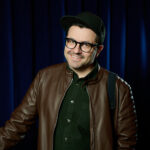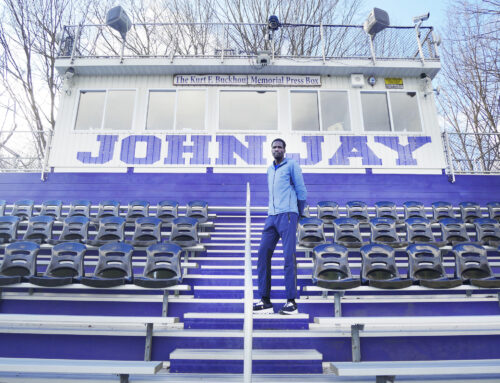We were recently introduced to Ukrainian artist Taras Borovyk, and even though he lives outside our coverage area in Carmel, we were so moved by his story that we wanted to share it with you. An artist who grew up in Ukraine, Borkovyk’s work has changed over the last several months. His electric reds now reflect blood rather than architecture; death rather than nightlife. His work shows crying faces, lifeless bodies and a country reeling from the helplessness of war. It’s how he’s able to process what’s happening to his family and his homeland. Borovyk is using his art to raise money for Ukraine.
Katonah Connect: That was not what I expected to see when I arrived! Who were you fighting with and why is he wiping blood off of his lip?
Taras Borovyk: That’s my martial arts partner.
KC: Wow! You two were really going at it in your studio. I just witnessed shelves shaking and easels rocking back and forth.
TB: This is what life is about. It’s a struggle. (He nods his head to a poster of Bruce Lee hanging from the ceiling of his studio space that said “Do not pray for a peaceful life. Pray for the strength to endure a difficult one.)
KC: Tell me what your life has been like these past several months.
TB: All my family and I can do right now is function. That’s it. My wife and I go to work. My children go to school and try to live life. But the war is all we can think about. My family live in Lviv in western Ukraine. My father’s home shook a few times from bombs dropping. And many of my friends have gone to the east to join in the fight. Anytime my phone rings, I don’t know what to expect.
KC: Do you have any other family in the states?
TB: They come to visit. My wife’s mother was visiting New York when the war broke out in February. She came to see her grandchildren, but she immediately left to return home. The airspace was already closed by then, so she flew to Warsaw and took a bus for twenty five hours to get to her house in Ukraine. She told me that she needed to help, and if she was going to die, she wanted it to be in her homeland.
KC: How are you managing the stress?
TB: I paint.
KC: When I look at your work, the word that comes to mind is electric. It reminds me of Van Gogh – the deep navy blues mixing with vibrant highlights of red, pink, yellow and gold. I love how you’ve decorated a typical Ukrainian street with splashes of neon. There’s a sense of motion and drama in an otherwise quiet cityscape.
TB: Since war broke out in February, my work has become more emotional. At two in the morning my mind is busy. I can’t stop thinking about the war. I can’t sleep, so I begin to work. I paint until I pass out in my chair. My latest collection is called “A Cry for Peace.” I have seen photos and videos from friends back home. These are things you don’t see on the news. These are things you can’t unsee.
KC: What was it like to grow up in Ukraine?
TB: I grew up in Lviv. War has run through my city. We grew up fighting Nazi Germans in the west and Soviets in the east. Later, we watched the copper coffins come back to our city. These were Russian soldiers who died in Afghanistan. Lviv is a bus stop where weapons and soldiers flow through constantly, even today.
KC: When did you begin painting?
TB: As a child, I attended two schools at the same time, one for standard education and the other for art. I would come out of my normal school around two o’clock, skip my homework, and then go straight to art school and be back home by eleven at night. Instead of high school, I chose to go to art school. There were only six students in my class. It was very prestigious but very difficult as well. The school would beat you with a stick if you didn’t work. They didn’t put up with any crap. I dropped out for a time, being a stupid teenager, but I eventually returned.
KC: What did you do next?
TB: My professors referred me to Lviv’s historic Palace of Arts, the largest museum in Ukraine. I became an exhibition designer. I set up large-scale displays and exhibitions for the museum. I worked under Ukrainian artist and architect Orest Skop, and he changed my life.
I had a father already, but he was like my other father. That’s how important he was. I worked with him for many years. He designed about twenty museums throughout Ukraine, and I was fortunate enough to work with him on some of those. I even learned how to acquire funding for museums. We literally designed, funded and built these structures ourselves. We would work on them nonstop. Sometimes the cement would still be wet when people entered the building on the first day.
KC: Are any of the museums still standing after the current Russian invasion?
TB: I hope so.
KC: What are you doing with all this work you’ve created recently?
TB: Painting is my therapy. If I didn’t have a family living here in New York, I would be fighting in Ukraine today. Instead, I am painting and working to raise money to send back to my country to help in the fight, feed the hungry and aid the injured.
I’m working with Ray (Benza of Entertainment Technology in Mt. Kisco) to sell my work, and I’m donating the proceeds to aid Ukraine. I hope to design a mural on the outside of his store to bring more awareness to the Ukrainian cause.
KC: What do you want others to know about the war in Ukraine?
TB: My whole life, I’ve had to hide under my desk at school, worry about nuclear war, and deal with dictators like Vladimir Putin. I’m sick of it, and I want to help however I can. Putin is not going to stop. Russia is not going to stop. So we cannot stop either. If my art is the best weapon I have to fight back, that’s exactly what I’m going to use.


Justin is an award-winning designer and photographer. He was the owner and creative director at Future Boy Design, producing work for clients such as National Parks Service, Vintage Cinemas, The Tarrytown Music Hall, and others. His work has appeared in Bloomberg TV, South by Southwest (SXSW), Edible Magazine, Westchester Magazine, Refinery 29, the Art Directors Club, AIGA and more.
Justin is a two-time winner of the International Design Awards, American Photography and Latin America Fotografia. Vice News has called Justin Negard as “one of the best artists working today.”
He is the author of two books, On Design, which discusses principles and the business of design, and Bogotà which is a photographic journey through the Colombian capital.
Additionally, Justin has served as Creative Director at CityMouse Inc., an NYC-based design firm which provides accessible design for people with disabilities, and has been awarded by the City of New York, MIT Media Lab and South By Southwest.
He lives in Katonah with his wonderfully patient wife, son and daughter.








